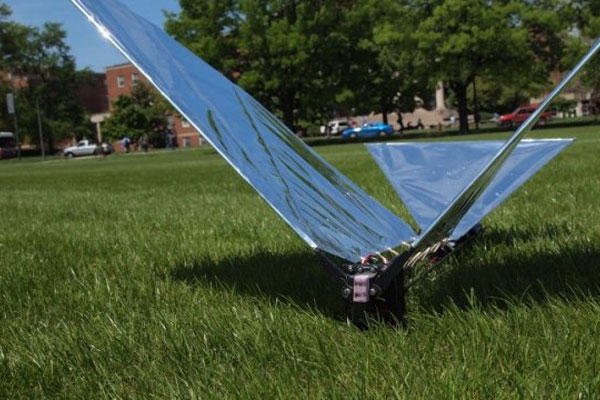A robotic bird created by Army and University of Maryland researchers is tricking real flocks -- and hawks -- midair, making it a potential unsuspecting future war agent.
Robo-Raven glides, soars and flaps like a real bird. Complete individual wing control allows for extreme aerobatics that no other mechanical bird has ever been able to perform, Army Research Laboratory researchers claim. But its ability to hide in plain sight and light weight is what excites researchers most.
"It already attracts attention from birds in the area which tends to hide its presence," said John Gerdes, a mechanical engineer with the Vehicle Technology Directorate at APG.
Seagulls, songbirds and sometimes crows tend to try to fly in a formation near the bird during testing, but birds of prey, like falcons and hawks take a much more aggressive approach toward test flights.
"Generally we don't see them coming," Gerdes said. "They will dive and attack by hitting the bird from above with their talons, then they typically fly away."
With the aggressive maneuvers they are working on, the perch and stare mission could be possible, and when combined with solar cell wings that the University of Maryland is working on, researchers could land and charge the Robo-Raven then resume a mission.
Robo-Raven is much quieter than the helicopter or propeller, so it could get much closer to an adversary without revealing its presence. It's made out of carbon fiber, 3D-printed lightweight thermalresistant plastic, Mylar foil and foam. The geometrically complex figure is shorter than two feet and weighs less than a can of soda.
Programmed wing motion helps Robo-Raven's wings maintain optimal velocity during the flap cycle to achieve the right balance at takeoff.
Gerdes, a doctoral candidate, began building Robo-Raven in 2008 as part of graduate research at the University of Maryland's Advanced Manufacturing Laboratory that focused on developing a tech demonstrator for manufacturing techniques that morphed into a variety of spinoff research efforts.
Dr. SK Gupta, a professor in mechanical engineering, began working on flapping-wing robotic birds nearly a decade ago. According to a University of Maryland news release, Gupta and his graduate students, along with mechanical engineering professor Hugh Bruck, first successfully demonstrated a flapping-wing bird in 2007. This bird used one motor to flap both wings together in simple motions.
By 2010, the design had evolved to more than four successive models. The final bird was able to carry a tiny video camera, could be launched from a ground robot that ARL researchers created called the Lynchbot, and could fly in winds up to 10 mph -- important breakthroughs for robotic micro-air vehicles that one day could be used for reconnaissance and surveillance.
Inside ARL laboratories, Gerdes tested motors to determine the power curves using a micro dynamometer. He also worked to model the aerodynamic forces generated during flapping. The wings are based on a design he created for his master's thesis project, but have been scaled up to match the more powerful motors the team is currently using.
Gerdes designed the prototype with Steven Biggs, a technician within ARL's Autonomus Systems Division, and a group of about six researchers at the University of Maryland.
The robot uses a fly-by-wire approach, so a handheld radio is used to control the flight.
Research funded by the Aviation and Missile Research, Development and Engineering Center investigates small and micro scale unmanned aerial systems that could allow Robo-Raven to fly autonomously.
Researchers are hopeful that someday, Robo-Raven could potentially become a fielded platform farther into the future.
"We were inspired by the capabilities of the bird much more than the anatomy of the bird," Gerdes said. "Our approach was more bio-inspired than bio-mimetic. In some ways this simplifies the design because we can focus on functional aspects without necessarily adopting the same set of constraints that apply to animals."
Gerdes said many of the design features that animals have evolved are a fantastic starting point, which can be seen in their design.
"For example, we use hollow stiffeners to provide a stiff and light-weight structure, and our wing spars have been arranged in a fan pattern to create the desired airfoil shape during the flapping motions," Gerdes said. "At any time, we can transition between these behaviors with total control over the wings."
The way they do this is to separately drive each wing with its own actuator, removing any coupling between the two wings, which has been the traditional approach to ornithopter (robotic bird) design.
"A major challenge in realizing this approach was overcoming the strict weight limitations," Gerdes said.
At this point, the bird isn't flying with sensors due to a very restricted payload, but advanced research is expected to improve their understanding of how a Soldier could use it, the microcontroller and the flight dynamics and ultimately enhance the robot's flight envelope.
Funding for the robotic birds project has been provided by the National Science Foundation, the Air Force Office of Scientific Research, the Army Research Laboratory, and the Army Research Office.




























